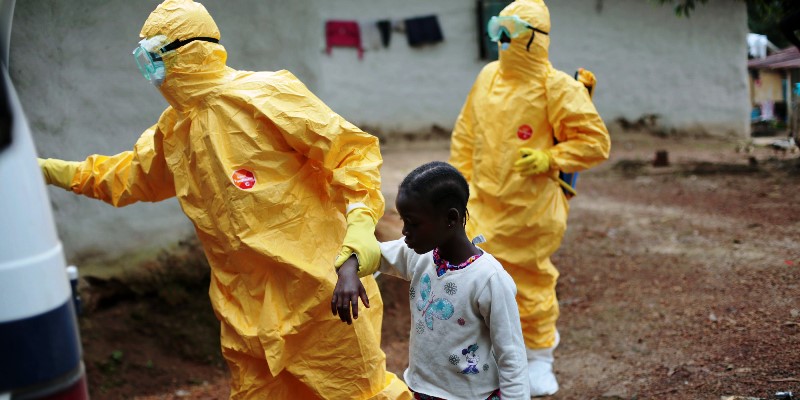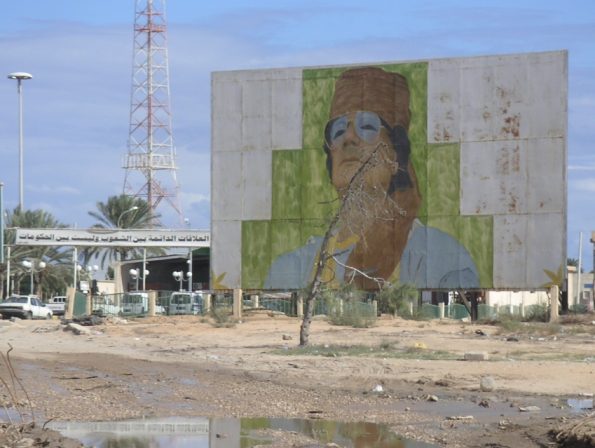
During the fallout from the 2014 Ebola outbreak in West Africa, which killed more than 11,000 people, one of the questions asked of the World Health Organisation (WHO) was why it hadn’t reacted more quickly. The four-month delay in pinning down the cause of the disease that erupted in Guinea’s remote Guéckédou province in December 2013 allowed what might have been a localised event in a single village to turn into the biggest infectious disease crisis of recent times.
There were a variety of reasons for this failure, many of which were discussed at length. But beneath all the breakdowns in structure, process and communication that became all-too apparent in West Africa in mid-2014, lurked a single fundamental fact known to all virologists: Ebola was not a West African disease. So why would anybody suspect it had broken out there?
The first patient of the West African Ebola outbreak was Emile Ouamouno, an 18-month-old boy. He died in Meliandou village, eastern Guinea, on December 6, 2013, followed closely by his sister, mother and grandmother. As the village outbreak slowly spread throughout the province in the weeks that followed, a variety of hypotheses about the cause of the deaths were considered. It was dysentery, or cholera, or typhoid or even just a really bad dose of malaria.
When the haemorrhagic symptoms – bleeding from the mouth, nose and other orifices – were noticed in some cases, Lassa fever became another potential explanation. Lassa, after all, is fairly commonplace in Guinea – and the symptoms seemed to fit. Except, of course, for the rather high death rate. Maybe Lassa was just particularly intense that season.
It was only in the middle of March 2014, when all reasonable hypotheses had been considered and rejected, that the teams from Médecins Sans Frontières and the Guinean health ministry arrived in Meliandou village to investigate the unreasonable hypothesis and order the testing of samples for Ebola. As we all know, they came back positive. The unthinkable had happened, while the medical authorities had been refusing to think it. And, worse than that, by then the outbreak had spread through the regional hospitals in Guéckédou and Macenta, had reached the teeming shanty town slums of Guinea’s capital Conakry, and the first cases had already been noted in the neighbouring country of Liberia to the south-east.
And so a new consensus about Ebola developed. A freak transfer of the disease, possibly by the migration of fruit bats, to an area where it had never been seen before, had blindsided diagnostic efforts that had rightly concentrated on more likely causes. Medical textbooks needed rewriting to include the new fact that Ebola had appeared for the first time in West Africa in late 2013 and that we have now completely revised our conception of the risk zone for Ebola in Africa. Go to any virology or microbiology conference these days and you are liable to hear something very similar. There is just one problem – it isn’t true.

To understand why, we need to look more closely at several issues. These include the way that Ebola virus disease (EVD) is diagnosed as well as disputes about how to detect a survivor of EVD long after an outbreak has ended and the diversity of the viruses that can cause EVD. We also need to consider the shadow cast by Guinea’s first president, one of Africa’s least predictable but most resilient autocrats, Ahmed Sékou Touré.
Each of these made a small contribution to the received wisdom that EVD is a disease of Central Africa only. Once that received wisdom became a “fact” and entered the medical textbooks, it became reasonable for a medical practitioner to delay ordering an Ebola test, even while people were dying all around of a haemorrhagic fever.
Yet outside the textbooks – in the more obscure tropical virology literature, in the notebooks of bush doctors and in the geopolitical manoeuvrings of Cold War dictators – Ebola was leaving its footprints over a far wider area of Africa. The way Ebola was studied, the way the results of those studies were interpreted – especially at a time of technological transition in the diagnostic field – and the way that certain of those results were covered up, had a direct and negative impact on our preparedness for future outbreaks. As a result 11,000 people died.
Strange new virus
EVD first appeared in 1976, in the village of Yambuku in the north of what had been Belgian Congo in colonial times, then the Democratic Republic of Congo in the 1960s, but which by the 1970s had been renamed Zaire by another of Africa’s flamboyant despots, Mobutu Sese Sékou. One of the legacies of Zaire’s colonial past was the presence of a field hospital in Yambuku, run by an order of Belgian missionaries. And it was to that hospital that the first case arrived, a school teacher who had become ill after taking his class on a trip down to the Ebola River. As the unfortunate man began to die of haemorrhage and dehydration, the nurses tried to save his life by giving him an injection of the anti-malaria drug chloroquine. We don’t know for sure what happened to the needle that was used, but the likelihood is that it was used again without proper sterilisation on other patients in the Yambuku hospital. Soon a single case became dozens.
People arriving in the hospital for more routine treatment were also infected and took the disease into the surrounding area. By the time the outbreak died down there had been nearly 300 deaths, including most of the hospital staff. Eventually, a blood sample was obtained from a dying nurse named Mayinga. Ferried back to Antwerp in Belgium for analysis, Mayinga’s blood yielded a completely new kind of pathogen, a strange looking virus, worm-like in appearance. This filovirus (the family designation being based on its filamentous structure) was classified as Zaire ebolavirus strain Mayinga, referencing the country of origin, the river where the unfortunate teacher had possibly picked it up and the nurse from whom the virus was isolated.

Over the next 20 years, EVD struck sporadically across Zaire and some surrounding countries. It became apparent that EVD could be caused by more than one type of virus. Outbreaks to the east of the Congo Basin were caused not by the classic Zaire ebolavirus but by Sudan ebolavirus. Another filovirus, Marburg, was found to be a slightly more distant relative. All three had the potential to generate rapid high mortality epidemics, although none had quite the magnitude of that first hospital outbreak in Yambuku. As the years passed, others were identified – Bundibugyo ebolavirus in Uganda, Tai Forest ebolavirus from a single human case in Ivory Coast (still the only isolation of this particular species) and Reston ebolavirus, an Asiatic variant so far only found in monkeys.
Virologists immediately began to wonder, where does this thing come from? Is it really new? Was 1976 really the first EVD outbreak, or just the first one we’ve noticed? They weren’t just asking these question about Ebola. A few years after the first appearance of EVD, AIDS began to make its presence felt in North America and Europe. It was soon learned that the AIDS epidemic in the West was dwarfed by the magnitude of AIDS in Africa, where millions were already infected. Could it be that EVD, AIDS and possibly many other serious viral infections had been circulating in Africa under the medical radar for decades?
And so it came about that virologists set off into remote areas of that continent crisscrossing them throughout the 1980s in an attempt to answer this question. Their mission was to find survivors of undetected EVD outbreaks of the past, and their main investigative tool was the “indirect immunofluorescence assay” (IIA), a method that involved dropping a pin prick of blood from a volunteer onto a microscope slide that had been coated with dried virus-infected cells. If the volunteer had antibodies against the virus in question, the cells would glow under a fluorescent light. That result meant that the volunteer had survived an encounter with that virus in the past.
All that was needed to conduct such a “serosurvey” (a survey of people who had been infected with EVD) was a box of diagnostic slides, a portable microscope with a fluorescent bulb, a battery or small generator to power it, a black blanket to make the fluorescence more visible in the African sunshine and a few disposable accessories for blood sampling. Serosurveys proliferated and, for Ebola, the results were striking. The Congo Basin zone within which confirmed EVD outbreaks had been recorded was situated within a much wider area where people showed distinct antibody traces of Ebola having passed through (see map below). Some of the serosurveys made direct suggestions about previous epidemics. One research group identified a suspiciously Ebola-like outbreak in Ethiopia in the early 1960s which had left its traces in the antibodies of Ethiopians but which had been classified at the time as yellow fever, another of Africa’s notorious infectious disease killers.

ELISA – the “gold standard”
By the early 1990s, IIA serosurveys had begun to go out of fashion. Enzyme-linked immunosorbent assay (ELISA) was a new technology for giving clean and quantitative measurements of antibody levels. IIA came to be considered antiquated, approximate and unreliable. It was particularly criticised for its tendency to produce false positive results, despite the fact that many of the IIA serosurvey authors took great pains, using various clever techniques, to demonstrate that their results were true positives.
ELISA became the gold standard in the field, but it had a major disadvantage: it needed large specialist machines to perform it, as well as computers, refrigerators and freezers. In short, it could only be done in a modern fully equipped research laboratory, of which there were a mere handful in Africa. Old-fashioned IIA took the researchers out to the villages, but ELISA needed blood to be shipped from the villages back to a lab which as often on the other side of the continent – or even overseas. Our serosurvey knowledge of Ebola’s past simply stopped growing, and those IIA results that were in the literature became the subject of doubt or even dismissal.
One of the first ELISA-based Ebola serosurveys was performed in Guinea in 1987. These samples had been kept in freezers for five years, having been collected during an outbreak of a mysterious disease in that country in 1982. The results of the analysis were positive, implying that Ebola had visited Guinea in 1982.
In 2014, Dr Cellou Baldé, a member of the Guinean-Russian team sent to investigate the 1982 outbreak at the time and subsequently a co-author of the 1987 paper, was interviewed by a Guinean newspaper. Baldé described how there had been considerable political pressure to downplay the 1982 outbreak. Although the clinical descriptions of haemorrhagic fever taken at the time strongly implied that EVD was present in Guinea, the last thing that Sékou Touré wanted was an international news story about Ebola in Guinea. In Baldé’s words: “President Sékou Touré simply wouldn’t hear of it.”
Sékou Touré was one of the great survivors of the Cold War in Africa. Having successfully led trade union agitation against French colonial rule, he went on to become Guinea’s first president and initially positioned himself as an ally of the Soviet Union and Cuba. But he moved progressively further to the left, identifying more closely with Maoism and China. The timing was poor. Mao Zedong died in 1976 and China withdrew from the Cold War arena. Left without a superpower ally, Sékou Touré then abruptly changed political direction. If the communist bloc could not supply what he needed, capitalism would have to.
Almost overnight Guinea became an ally of the West – and its government began to make major overtures to attract foreign investment. But investors wanted stability and safety, so Ebola could not be seen to be present in Guinea. The blood samples went into the freezer and the outbreak medical reports into a locked filing cabinet. Only in 1987, three years after Sékou Touré’s death, could the samples be analysed and published.
Paranoid Cold War cover-ups aside, there was other evidence of Ebola in West Africa prior to 2014. In the IIF era, another 1982 study had detected individuals with antibodies to Ebola in Liberia, also hit hard by EVD in 2014. More recently, labs set up in the third country of the 2014 West African outbreak, Sierra Leone, to screen for Lassa fever, which causes a milder disease with many similarities to EVD, had also begun screening for Ebola using ELISA technology. In samples from Sierra Leone collected from 2006-2014, antibodies to Ebola were detected.
Either Ebola itself, or something closely related to it, appears to have been circulating widely across a large area of Africa, even though recognised EVD outbreaks were confined to the Congo Basin and surrounding areas until 2014. All this had been established prior to the West African epidemic, but the idea that Ebola could be present beyond its textbook range was not widely realised, even among scientists.

Warning for the future
What were the reasons for this blind spot? Part of the explanation may be found in the natural scepticism of scientists. Where there is a confirmed EVD outbreak, undoubtedly Ebola has been there – and live virus has been isolated from patients in most of these outbreaks. This is the hard evidence. But the serosurvey results – although not able to conclusively demonstrate the presence of Ebola itself, but rather only of antibodies to Ebola in surviving individuals – were too quickly dismissed as second-class evidence.
There are distinct traces of something – perhaps one of the four known EVD-causing ebolaviruses, or perhaps an as yet undiscovered close relative – infecting people across a wider area of Africa, from Ethiopia in the north to Zimbabwe in the south, from Kenya in the east to Sierra Leone in the west. What that might be is open to discussion.
Perhaps the four known EVD-causing ebolaviruses (Zaire, Sudan, Bundibugyo and Tai Forest) do not always produce a full-blown EVD. In other words, outbreaks may vary in intensity and we only recognise EVD outbreaks at the more extreme end of the scale. Perhaps there are other undiscovered members of the filovirus family (which also contains the lethal Marburg viruses), close enough to the real thing that an encounter with them will generate antibodies in survivors that give an ELISA or IIA signal that looks like Ebola. Perhaps the issue is not severity but size. If most EVD outbreaks are very small and in isolated areas (like the latest 2017 outbreak in Congo with just eight cases and four deaths), they may not be noticed.
Whatever the serosurveys are telling us, they serve as a warning for the future. Scepticism around the validity of antique 1980s IIA methods remains, but at least one of the areas where the serosurveys turned up antibodies has now also been through a full EVD outbreak -– and that outbreak was one of unprecedented devastation.
![]() The accepted wisdom is that since 2014 we can no longer claim that we know where Ebola is to be found based on previous EVD outbreak distribution alone. But we never really could claim that at any time. Even Sékou Touré’s suppression of the news of the 1982 outbreak in Guinea was ultimately a failure. And where the dictator failed, the scientific community completed the job by leaving the results unread, dismissed or disregarded for 27 years – until, in 2014, Ebola finally came calling again.
The accepted wisdom is that since 2014 we can no longer claim that we know where Ebola is to be found based on previous EVD outbreak distribution alone. But we never really could claim that at any time. Even Sékou Touré’s suppression of the news of the 1982 outbreak in Guinea was ultimately a failure. And where the dictator failed, the scientific community completed the job by leaving the results unread, dismissed or disregarded for 27 years – until, in 2014, Ebola finally came calling again.
Derek Gatherer, Lecturer, Lancaster University
This article was originally published on The Conversation. Read the original article.



